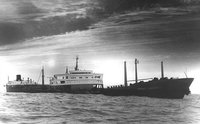Depending on what source you read it was either Saturday March 18th or Sunday 19 March 1967 that the Torrey Canyon grounded on the Seven Stones Reef between Lands End and the Islands. She was sailing for Milford Haven with 120,000 tons of Kuwaiti oil.
- Job: Bulk Oil Carrier
- Tonnage: 119,328 tons
Incident
- Difficulty: Ran aground, wrecked
- Date: 19 March 1967
- Shipping route: to Milford Haven
- Passengers & cargo: 119,328 tons of oil
- Location: Sevenstones Barrier Reef
The immediate response was to try and salvage her. Thirty thousand gallons of oil had escaped from the tanker and was moving steadily towards the Cornish coast by the prevailing wind and current. Detergent was used by Royal Navy vessels to try and disperse the oil. The Torrey Canyon had started to break up and Harold Wilson and his cabinet held a mini cabinet meeting at Royal Naval Air Station Culdrose and decided to order the setting fire to the remaining oil, to try and avoid the oil disaster getting worse.
In the meantime HMS Daring was in the middle of her work-up at Portland. This is when the ship and the men are put through every eventuality conceived, to test whether the men and the ship are proficient to become part of the operational fleet.
Given that the following dates of the bombing are accurate, we sailed in the early hours of Monday morning, that must have been the Easter Monday, 27 March 1967. Approximately seven sailors had just got off a coach at 04.00 from weekend leave and realising what was happening they quickly ducked behind one of the buildings on the pier, not wanting to go to sea that day. The First Lieutenant had spotted them from the Daring?s bridge wing and shouted at them to get onboard. As soon as they were onboard the gangway was raised and the ship sailed. The ship had been at 8 hours notice for steam and yet achieved the impossible by being ready for sea within just 3 hours!
Timeline
- 18 March 1967: Torrey Canyon grounded on reef
- 27 March: HMS Daring shipped off to scene
- 28 March: Bombs dropped by Fleet Air Arm. Oil dropped to aid fires. Further air strikes by RNAS Yeovilton and RNAS Brawdy craft.
There were quite a few ships company left behind, as leave didn’t finish until 07:30 that morning. Only half the ship’s cooks were onboard. The communicators onboard worked watches of six hours on and six hours off for the three days we were required to be on station.
Daring’s presence was required as a range safety ship to keep all unwanted shipping well away from the Torrey Canyon wreck. There were a large number of Russian trawlers (bristling with aerials) all jockeying for a good position to view the bombing, presumably.
On Tuesday 28 March 1967 the Fleet Air Arm sent Buccaneers from Lossiemouth to drop forty-two 1,000-pound bombs on the wreck. This was followed by the Royal Air Force in sending Hunter jets to drop cans of aviation fuel to make the oil blaze. Seventy five per cent of the bombs were on target and both sections of the wreck were on fire.
Statistics
- 42 bombs dropped
- 25% missed target
- 270 sq mi of oil in sea
- 73 mi oil on coastline
- 540 kl crude oil spilled
However, exceptionally high tides had put the blaze out and it took further attacks by Sea Vixens from the Naval Air Station at Yeovilton and Buccaneers from the Naval Air Station at Brawdy as well as more RAF Hunters with napalm to ignite the oil until the wreck was free from oil.
Crowds of holidaymakers were watching the spectacle from the shoreline at Lands End. Though the bombing was declared a success the Press made much of the twenty five per cent of misses on a stationary target.
After Daring had completed her guard ship duties we then sailed back to Portland to continue with our work-up.
Other warships employed with the surface operations were Barorosa, Delight, Aurora, Eskimo, Carysfort, Blackwood, Clarveston, Wotton and Nurton. Another task force for the Channel Islands operations consisted of Pellew, Laleston, Belton, Highburton and Soberton. Thousands of gallons of detergent were sprayed on the 270 square miles of sea contaminated by the oil slick. Ninety three miles of Cornish coastline was affected. This was the first major oil tanker disaster and sadly not the last.


